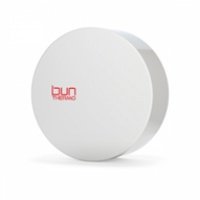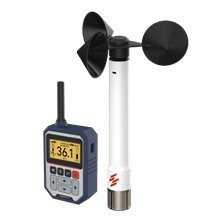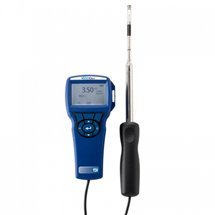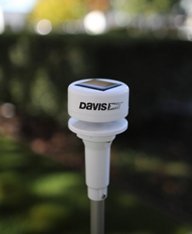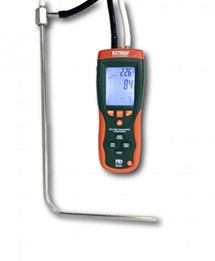Anemometers - What are They Used For?
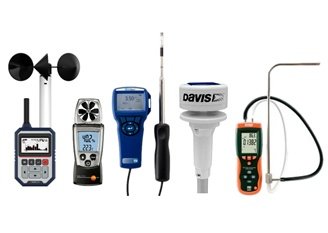
Difficult to pronounce but easy to define, an anemometer is a device used to measure wind speed and often wind direction. The uses for anemometers will vary depending on the type, and this requires an understanding of the five main anemometer types.
Types of Anemometer
All anemometers measure wind speed. The main difference is the method they use to measure wind speed. See below how our scientists detail each of the five main types, including the different methods of determining wind speed, with pros and cons. They have also provided examples of representative products.
1. Cup Anemometer
Cup anemometers consist of three cups attached to arms that mount on a vertical rod. As the wind speed increases, the cups spin freely. A hall effect sensor or reed switch measures the number of rotations in a period and converts rotations into a wind speed measurement.
Cup Anemometer Benefits
- Measure wind speed regardless of wind direction.
- You’ll find a wide variety of cup anemometer designs available (e.g., metal or plastic cups) to meet the needs of various applications.
What is a Cup Anemometer used for?
Applications include:
- Construction sites
- Mines
- Building sites, particularly with cranes in operation
- Farms; and
- Schools.
|
Product Example: WR-3 Plus Wireless Anemometer Kit
|
2. Hot Wire Anemometer
Hot Wire Anemometers measure wind speed using the principle that the colder impact of wind flow extracts heat. They use a fine wire heated a few degrees above the ambient temperature. The device will try and keep the wire at a constant temperature while any air flowing past will start to cool it. The meter will then measure the current needed to keep the wire temperature constant and convert this metric to an air velocity reading.
How Wire Anemometer Benefits
- High sensitivity in low wind speed environments
- Operate well in elevated temperatures
What is a Hot Anemometer used for?
Hotwire anemometers perform best in environments with stable temperatures, for example:
- Checking flow foods
- Exhaust monitoring; and
- Various HVAC applications.
|
Product Example: TSI 9535 Velocicalc Air Velocity Meter and Data Logger
|
3. Vane Anemometer
Vane anemometers measure wind speed using propellers, turbines, or impellers. Like a wind cup anemometer (see above), vane anemometers have a reed switch or sensor that counts turbine rotations within a specific timeframe. The processor converts rotations to a windspeed measurement. Unlike cup anemometers, you must face vane anemometers in the direction of the wind source to obtain a measurement.
Vane Anemometer Benefits
- Small, convenient, and widely used.
- It can operate at higher velocities than hot wire anemometers.
What is a Vane Anemometer used for?
Vane anemometers can operate indoors and outdoors. They work best when the wind direction remains consistent. Common applications include:
- HVAC Monitoring
- Measuring hoods and airflow equipment
- Water treatment plants
- Exhaust monitoring; and
- Education.
|
Vane Anemometer Example: Vane Anemometer with Temperature & Humidity Measurement
|
5. Ultrasonic Anemometer
Ultrasonic anemometers are “new kids on the block” compared to cup or vane ones. Ultrasonic anemometers use electro‐acoustic transducers to send sonic pulses back and forth. Because air movement affects the time a pulse takes to travel between transducers, ultrasonic anemometers can exploit detected time variations to calculate wind speed.
Ultrasonic Anemometer Benefits
- No moving parts: Ultrasonic anemometers do not incur maintenance costs.
- Inertia does not impact accuracy: Wind cups and vanes are almost always moving. When there's a sudden drop in wind speed or change in wind direction, the moving parts will need to adjust – resulting in a slight measurement lag. With no moving parts to account for, the technology behind sonic anemometers facilitates real-time measured values.
What is an Ultrasonic Anemometer used for?
Ultrasonic Anemometers are ideal for long term and remote deployments in places like:
- Mine sites
- Construction sites
- Tower cranes
- Weather buoys; and
- Environments with salty air or substantial amounts of dust could affect the accuracy and reliability of traditional cup or vane anemometers.
|
Product Example: 6415 Sonic Anemometer
|
6. Pitot Tube Anemometer
Pitot Tube Anemometers are suitable for measuring mid-to-high range wind velocity at mid-to-high range temperatures. A pitot tube design consists of two holes in a tube. The first hole at the front faces the wind direction and measures stagnation pressure, and the second hole is located on the side of the pitot tube and measures static pressure. The anemometer will then determine the difference between these two pressure measurements to generate a dynamic pressure reading and convert that reading to a wind velocity measurement. While it sounds complicated, the device captures velocity measurements within a matter of seconds – neat!
Pitot Tube Anemometer Benefits
- Low cost
- No moving parts, and
- Cause little pressure loss.
What is a Pitot Tube Anemometer used for?
Pitot tube anemometers are suitable for use in elevated temperature and high wind velocity environments, for example, monitoring:
- Flow hoods
- Exhaust vents; and
- HVAC/R systems.
|
Product Example: Pitot Tube Anemometer with Differential Manometer
|
Conclusion: What Is an Anemometer Used For?
An anemometer is a device used to measure wind speed. When searching for a device to measure wind speed, it’s important to narrow your options and save time by first determining what type of anemometer will best suit your needs.
Need more information on anemometers? Need a hand finding the best for your application? Speak with an Instrument Choice Scientist: Call 1300 737 871 or email [email protected].
Also interesting
Instrument Choice's team of scientists regularly reviews new and popular products, so you can make informed decisions when searching for the perfect scientific instrument for your application.
This edition reviews the reliable and affordable LCD-V-1 LCD Vernier Type Digital Calipers, a precision measuring tool brimming with intelligent and user-friendly features.
Get a scientists' review of the LCD-V-1 LCD Vernier Type Digital Calipers.

Instrument Choice proudly stocks over 150 brands of scientific instruments and laboratory equipment. To help you find the best products to suit your application, our scientists regularly spotlight brands to help you learn about the best manufacturers and the products they offer.
In this edition, we check out Loggerflex, the innovators behind the bun series of smart data loggers that log and wirelessly send critical information about their surrounding environment to a cloud-based platform.
Check out the impressive Loggerflex smart, WIFI data loggers
